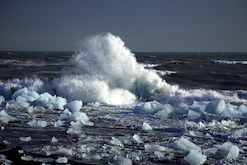Arctic waters impacted by floating plastic debris due to ocean currents
EU support to the MICRO B3 project has fed into the research published in ‘Science Advances’. The team found that although pollution sources were distant, and plastic debris absent in most of the Arctic waters surveyed, it reached high concentrations in the farthest northern and eastern areas of the Greenland and Barents seas. The scientists analysed the magnitude, distribution, and sources of the plastic pollution on the surface waters of the Arctic Ocean based on the Tara Oceans 2013 circumpolar expedition. The MICRO B3 (Marine Microbial Biodiversity, Bioinformatics and Biotechnology) project ended in 2015 but the project’s support is acknowledged by Tara Oceans. During the circumpolar expedition, Andrés Cózar and his colleagues used nets to collect floating plastic debris, including fishing lines and a variety of plastic films, fragments and granules. Hundreds and thousands of pieces of floating debris per square kilometers were identified, the fragmentation and typology of which leads the researchers to conclude the plastic was old and from distant sources. Accounting for its presence the paper states, ‘Surface circulation models and field data showed that the poleward branch of the Thermohaline Circulation (THC) transfers floating debris from the North Atlantic to the Greenland and Barents seas.’ This would be a dead end for what they describe as a ‘plastic conveyor belt’. Worryingly the team believes that, due to the limited surface transport of the plastic and the mechanisms provoking downward transport, the seabed of the Arctic sector concerned could be an important sink of plastic debris. Although human population north of 60° latitude is low, the paper mentions the circulation model set out by van Sebille and co-workers, which predicts a plastic accumulation zone in the Arctic Polar Circle, especially in the Barents Sea. This sector of the Arctic Ocean plays a key role in the global THC through the formation of deep water by cooling. The researchers explain that as the THC advects warm surface water from low to high latitudes across the North Atlantic Ocean to the Arctic. It could collect buoyant plastic from populated latitudes. Once in Greenland and Barents seas the landmasses and polar caps would trap the debris. Testing showed that although the Arctic Polar Circle was slightly polluted with plastic debris, in the Greenland and Barents seas debris was both abundant and widespread. The team found that maximum concentrations were lower than in the subtropical accumulation zones but the median values were similar, especially in units of number of items. ‘The total load of floating plastic for the ice-free waters of the Arctic Ocean was estimated to range from around 100 to 1 200 tons, with 400 tons composed of an estimated 300 billion plastic items as a midrange estimate,’ reports the paper. Given the wide range, the researchers say the study needs to be considered as a preliminary, first-order approximation. An increased sampling resolution to reduce the confidence interval associated with the variability in the spatial concentrations of plastic and the effect of the wind-induced vertical mixing is required, they assert. For more information, please see: CORDIS project web page
Countries
Germany



